Samsung SGH-D900 Ultra-Slim Mobile Phone Review
Samsung SGH-D900 Ultra-Slim Mobile Phone
Is the super-slim D900 a worthy successor to the excellent Samsung D600?
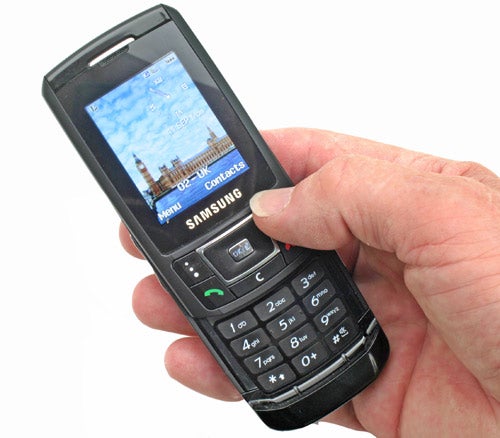
Verdict
Samsung has made incredible leaps forward in the past few years. It wasn’t that long ago that you considered a Samsung when you couldn’t afford a tier one brand like Sony or Panasonic, but those days are long gone. These days, not only is Samsung considered a tier one brand, it has actually cemented itself as one of the most desirable tier one brands out there. Samsung achieved this feat by doing two things. First, it spent an absolute mint on marketing its brand, but second (and far more important), it started to manufacture some truly excellent products.

You see Samsung is turning into one of those rare companies that seems to be able to turn its hand to anything and make a success of it. It wasn’t that long ago when Samsung mobile phones represented the “also ran” option in your local retailer, but then the D500 hit the streets and everything changed. The D500 was a runaway success and the follow up D600 expanded on that formula to become, arguably the best handset of its time. A year ago when the D600 was launched, no other handset was offering a 320 x 240 screen, coupled with a 2-megapixel camera and a memory card slot all wrapped up in a sleek and stylish package. In fact the D600 was so good that even Samsung had trouble bettering it – the D800 was a sorely disappointing handset, so disappointing in fact that I never even got around to reviewing it.
But now Samsung thinks that it has a worthy successor to the D600 in the shape of the originally named D900. The D900 is part of Samsung’s new Ultra range of slim and stylish phones. The D900 is a slider, like the D600 before it, while the D830 and X820 are flip and candy bar models respectively. There’s no denying that the D900 is very slim indeed, and when viewed in profile, the D600 looks obese by comparison. However, this is offset by the fact that the D900 is also far wider than the D600, so it doesn’t fit quite as snugly in your hand. In fact if you compare the size of the two phones you’ll see that the D900 is smaller only in one of the three dimensions.
”’D600 – 96 x 46.5 x 21.5mm (HxWxD)
D900 – 103 x 51 x 13mm (HxWxD)”’
Looking at it like that, the D900 doesn’t appear to be enough of a svelte beauty to put the D600 into the shade. However, despite being a bit on the long and wide side, the D900 is 10g lighter than its sibling, weighing in at a mere 93g compared to the 103g D600 – at least according to the Samsung spec sheet anyway. Interestingly, when I actually weighed the D900 I found that it only weighed 83g, making it 20g lighter than the D600 and a whole 40g lighter than the Sony/Ericsson K800i. You may not think that 20g makes much of a difference, but believe me, if you hold a D600 in one hand and a D900 in the other, the latter is clearly lighter. It feels lighter in your pocket too.
One of the slight annoyances on the D600 was that Samsung chose to remove the raised ridge beneath the screen that aided sliding. This left you having to push from the screen itself with the flat of your thumb (easier if you have sweaty fingers), or push from the base of the phone, which was quite precarious and could often result in you dropping the handset. Thankfully Samsung has learned from this mistake and reinstated the ridge below the screen on the D900, making opening and closing the handset a breeze. Good thing too, because you couldn’t slide the D900 from the bottom even if you wanted to, since the sliding section no longer covers the entire body of the phone; instead there’s a lip at the bottom. This could be a result of user feedback from people who dropped their phones when trying to slide them from the bottom, but the lip does make the phone longer than it needs to be.
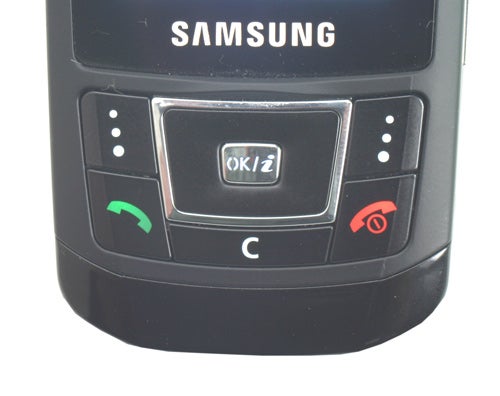
The button configuration below the screen is standard fare, and pretty much identical to the D600. The D900 uses real buttons rather than the touch sensitive controls seen on the E900 – whether this is a good thing depends on your view of touch sensitive buttons, but personally I’d rather have buttons that need to be pressed. What you’ve got is a four-way navigation pad with an OK button in the centre. You’ve also got two soft buttons, a Cancel button and finally Call and End buttons.
Slide the front of the phone up and you’ll reveal the keypad. Unlike the D600, the keypad is completely flush with the surface, making it slightly less tactile – this makes it harder to dial your number without looking at the keys, although the keys still have some travel to them when pressed. I’ve heard reports that it’s hard to press the bottom row of keys due to the lip at the bottom of the phone, but I didn’t encounter any such problems. That said, I do have pretty small fingers and I can see how anyone with large hands could have a problem.

On the left side of the chassis is a volume rocker and a microSD card slot. The latter allows you to augment the internal 70MB of user accessible storage. You don’t get a card in the box, but since memory cards are so cheap these days, that’s not a huge issue. On the right side is a camera shortcut button and the charge/sync/headset connector. Unlike the D600 which had separate connectors for power/sync and headset, the D900 has rolled them all into one, although the downside is that older Samsung chargers won’t work with the new phones. Having everything using one connector also means that you won’t be able to listen to music while you’re charging the phone.
One feature that I do really like is the “My Menu” screen. If you push the navigation pad UP from the home screen, a small submenu opens with shortcuts to five applications. You can populate the My Menu screen with whichever applications you use most regularly – believe me it’s a real bonus to get to the alarm app in two clicks.
Call quality is as good as I’d expect from a Samsung handset – as long as you have a decent signal the audio quality from the speaker is very impressive. And talking of signals, the ultra thin nature of the D900 doesn’t seem to affect its reception quality in any way. Unfortunately, like the D600 before it, the D900 doesn’t support voice dialling, which is a real pain if you’re in the habit of using a Bluetooth headset.
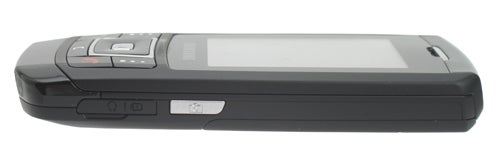
Talking of Bluetooth, the D900 supports stereo Bluetooth headphones as well as the standard file transfer and headset fare. This means that you can stream your music from the phone direct to a set of headphones, without any cables in the way. Obviously this is pretty cool if you don’t mind having a set of large Bluetooth enabled headphones covering your ears. Far cooler however, is that I’ve spent the morning streaming music from the D900 to a set of Parrot Bluetooth speakers (a full review of which will be coming soon), so the whole office can enjoy (endure) my playlists.
If you happen to get a phone call while you’re streaming music to a Bluetooth device, the music will pause and the D900 will ring as normal, with your chosen ring tone. When you’ve finished the call you can continue listening to your music from where you left off.
One of my criticisms of the D600 was that Samsung moved the camera to the outside of the body, rather than hiding it on the back of the slide like the D500 – this left the camera open to the elements and meant that the lens was often covered in dust and dirt. Thankfully the D900 harks back to the D500 and once again hides the camera on the back of the slide. When you raise the slide you’ll see the camera lens, a self portrait mirror and a flash – although it’s more of a bright light than an actual flash.
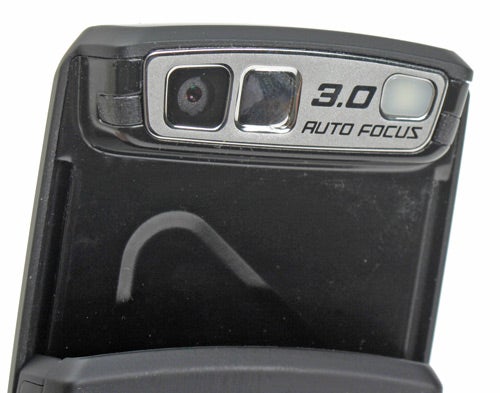
The camera is a 3-megapixel affair, producing images up to a maximum resolution of 2,048 x 1,536, which is an improvement over the D600’s 2-megapixel camera. However, I’m not completely convinced that the camera in the D900 is actually better than the one in the D600. OK, it shoots higher resolution images, and if you’re shooting static objects it turns in some good results, but the shutter lag can only be described as horrendous. Now, there was a degree of shutter lag on the D600, but the D900 takes things to a new level. Taking any pictures of my eight month old daughter for instance was impossible. No matter how hard I tried the image came out blurred because she’s always moving. On the D600 however, I have a veritable photo library of clear shots of her.
I’m a sucker for cool gadgets, so I have to admit that I was won over by the animated wallpaper that shipped with the D900. The image of the Houses of Parliament (despite being round the wrong way) looked great with the odd bird flying by and the cloud cover changing throughout the day. The best bit though, was as the time crept towards evening and the image correspondingly changed to a night view.
—-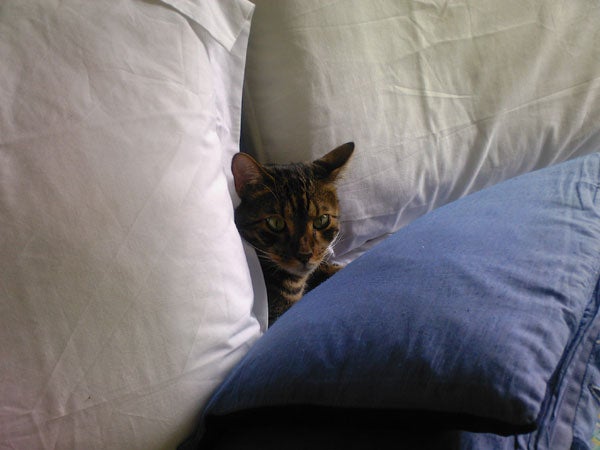
”’One of my cats hiding from his brother – he was keeping still enough for the D900 to grab a decent image.”’
—-
The menu setup has been completely revamped with very cool looking minimalist icons. When you dip into a category and scroll through the options, a second window opens with a list of the submenu options. This does make navigation easier since you can see what is in each menu without having to actually delve into them.
Of course the D900 can perform all the same file viewing party tricks as the D600 – you can view MS Office documents and PDF files, which is handy if you need to have a map or itinerary in your pocket. Of course this usefulness is limited by the small screen – the screen on the D900 is only slightly larger than the D600 at 2.2in compared to 2in, but it shares the same 240 x 320 resolution.
Samsung has also updated the T9 predictive text in the D900 so that it automatically capitalises a word that follows a full stop – the D600 didn’t do this and it was something that annoyed a lot of users, including myself.
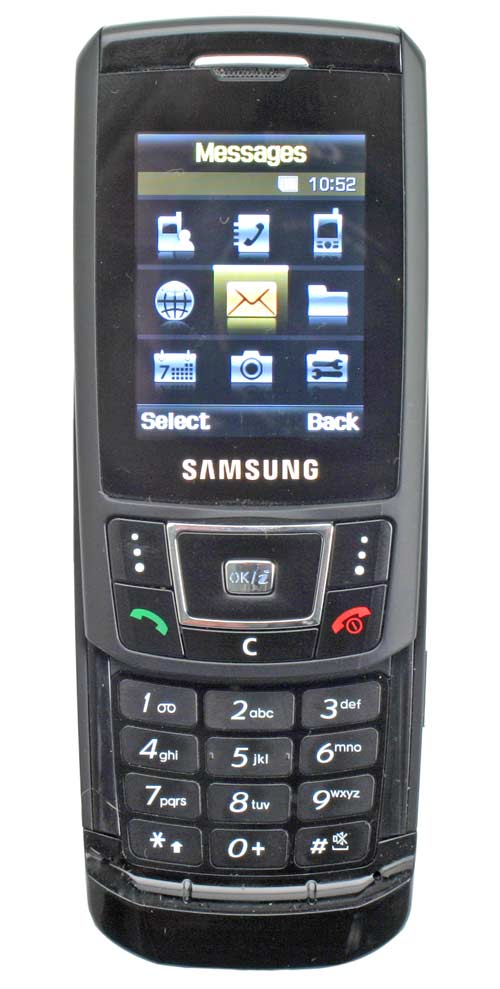
The D900 is a quad band phone (GSM 850, 900, 1800 and 1900), so it should work pretty much anywhere in the world. It’s also EDGE compatible, so the data rates will be pretty quick, although not up to 3G standards. That said, you’re not likely to get much EDGE coverage unless you’re on the Orange network in the UK.
It’s clear that the D900 has pretensions of being a smartphone, since Samsung has seen fit to include an Offline Mode (Flight Mode), which turns off the antenna, allowing you to use the phone on a plane. OK, so the D900 will handle email and can be used for viewing documents, but would I use it as a serious work tool on a plane? I think not. This is a slim and light phone and not a smartphone – if I wanted to create a document or write a long email I’d use my SPV M3100.
In the box you’ll find the phone, a charger, a USB cable and a wired headset. Unfortunately Samsung still insists on using the same headset that doesn’t allow you to use separate headphones. This is a shame, because these headphones are simply not good enough to allow you to use the D900 as a proper music player. Conspicuous by its absence is the TV-out cable that shipped with the D600, but considering the image quality that you get on a big screen, you’re not missing much.
Obviously cost is slightly moot with mobile phones, since if you’re upgrading or entering into a new contract you’re likely to get the handset for free, and things are no different with the D900. You can pick this phone up for free on pretty much any tariff around the £25 – £30 mark, which isn’t bad at all.
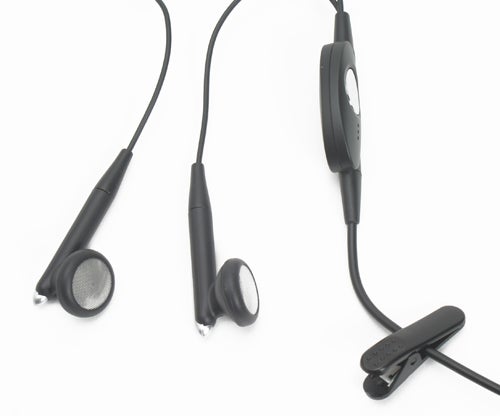
So is this phone a worthy upgrade to the D600? Well in some respects it’s a resounding success, but in others it’s a little disappointing. I actually find the handset slightly too wide, while it also feels a little on the long side – to be honest I actually prefer the dimensions of the Samsung E900, even though it’s not as slim. Also, the potentially great 3-megapixel camera is sullied by the most awful shutter lag I’ve seen in years. Is that enough to put me off the D900 entirely? Not at all. In fact I like this phone a lot and will miss it when it goes back to Samsung, but when I think what a revolution the D600 was, I guess I expected more from this svelte beauty.
”’Verdict”’
An undeniably slim and sexy phone that’s let down by a few design and usability issues. It’s a handy 40g lighter than the Sony/Ericsson K800i though and consequently sits unobtrusively in your shirt pocket. Although it’s worth remembering that the K800i works on 3G networks too. Would I recommend the D900 to current D600 users? Most definitely, but just don’t expect it to feel like a giant leap forward like the D600 did over the D500 before it.
How we test phones
We test every mobile phone we review thoroughly. We use industry standard tests to compare features properly and we use the phone as our main device over the review period. We’ll always tell you what we find and we never, ever, accept money to review a product.
Trusted Score
Score in detail
-
Usability 7
-
Value 8
-
Features 8
General
| Weight (Gram) | 3 ozg |
Battery
| Talk Time (Minute) | 5 Hourm |
| Standby Time (Hour) | 250 Hourhr |
Storage
| Internal Storage (Gigabyte) | 60 MBGB |

